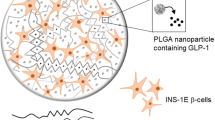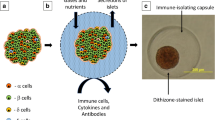Abstract
Designing biocompatible materials to encapsulate xenogeneic insulin-releasing β-cells for transplantation has been considered as a promising alternative to avoid the immunosuppression and drawbacks of the treatment of Type 1 diabetes mellitus (T1D) by direct islet transplantation. The current work for the first time studied a hybrid alginate@TiO2 microcapsule as a reservoir for rat insulinoma-derived INS-1E cells, as a β-cell surrogate, towards the treatment of T1D. The hybrid microcapsule is composed of an alginate core as a biocompatible matrix for cell encapsulation and a crack-free TiO2 shell as a semipermeable membrane to prevent cell leakage, protect encapsulated cells from immune attacks, as well as allow the diffusion of nutrients and the secretion of insulin. Compared to most-commonly used pure alginate microcapsules, the insulin-secreting INS-1E cells encapsulated in our alginate@TiO2 microcapsules revealed higher metabolic activity and maintained the insulin secretion over more than 6 weeks. This study highlights that our designed alginate@TiO2 hybrid microcapsules can serve as an ideal reservoir for cell encapsulation towards the treatment of T1D, thus further promoting the development of artificial organs for cell therapy.







Similar content being viewed by others
References
Van Belle TL, Coppieters KT, Von Herrath MG (2011) Type 1 diabetes: etiology, immunology, and therapeutic strategies. Physiol Rev 91(1):79–118
Tauschmann M, Hovorka R (2018) Technology in the management of type 1 diabetes mellitus—current status and future prospects. Nat Rev Endocrinol 14(8):464–475
Shapiro AMJ, Pokrywczynska M, Ricordi C (2016) Clinical pancreatic islet transplantation. Nat Rev Endocrinol 13:268–277
Ellis C, Ramzy A, Kieffer TJ (2017) Regenerative medicine and cell-based approaches to restore pancreatic function. Nat Rev Gastroenterol Hepatol 14(10):612–618
Shapiro AJ, Ricordi C, Hering BJ, Auchincloss H, Lindblad R, Robertson RP, Secchi A, Brendel MD, Berney T, Brennan DC (2006) International trial of the Edmonton protocol for islet transplantation. N Engl J Med 355(13):1318–1330
Ryan EA, Paty BW, Senior PA, Bigam D, Alfadhli E, Kneteman NM, Lakey JR, Shapiro AJ (2005) Five-year follow-up after clinical islet transplantation. Diabetes 54(7):2060–2069
Chang R, Faleo G, Russ HA, Parent AV, Elledge SK, Bernards DA, Allen JL, Villanueva K, Hebrok M, Tang Q (2017) Nanoporous immunoprotective device for stem-cell-derived β-cell replacement therapy. ACS Nano 11(8):7747–7757
Jenssen T, Hartmann A (2015) Emerging treatments for post-transplantation diabetes mellitus. Nat Rev Nephrol 11:465–477
Desai T, Shea LD (2017) Advances in islet encapsulation technologies. Nat Rev Drug Discov 16(5):338–350
Foster GA, García AJ (2017) Bio-synthetic materials for immunomodulation of islet transplants. Adv Drug Deliv Rev 114:266–271
Calafiore R, Basta G (2014) Clinical application of microencapsulated islets: actual prospectives on progress and challenges. Adv Drug Deliv Rev 67:84–92
Ma M, Chiu A, Sahay G, Doloff JC, Dholakia N, Thakrar R, Cohen J, Vegas A, Chen D, Bratlie KM, Dang T, York RL, Hollister-Lock J, Weir GC, Anderson DG (2013) Core-shell hydrogel microcapsules for improved islets encapsulation. Adv Healthc Mater 2(5):667–672
Dolgin E (2016) Diabetes: encapsulating the problem. Nature 540:S60–S62
Bisceglie V (1934) Über die antineoplastische immunität. Z Krebsforsch 40(1):122–140
Mount NM, Ward SJ, Kefalas P, Hyllner J (2015) Cell-based therapy technology classifications and translational challenges. Philos Trans R Soc B Biol Sci 370(1680):20150017
Trounson A, McDonald C (2015) Stem cell therapies in clinical trials: progress and challenges. Cell Stem Cell 17(1):11–22
Leonard A, Dandoy P, Danloy E, Leroux G, Meunier CF, Rooke JC, Su B-L (2011) Whole-cell based hybrid materials for green energy production, environmental remediation and smart cell-therapy. Chem Soc Rev 40(2):860–885
Sun J, Tan H (2013) Alginate-based biomaterials for regenerative medicine applications. Materials 6(4):1285–1309
Lee KY, Mooney DJ (2012) Alginate: properties and biomedical applications. Prog Polym Sci 37(1):106–126
Seliktar D (2012) Designing cell-compatible hydrogels for biomedical applications. Science 336(6085):1124–1128
Strand BL, Coron AE, Skjak-Braek G (2017) Current and future perspectives on alginate encapsulated pancreatic islet. Stem Cells Transl Med 6(4):1053–1058
Vegas AJ, Veiseh O, Gürtler M, Millman JR, Pagliuca FW, Bader AR, Doloff JC, Li J, Chen M, Olejnik K (2016) Long-term glycemic control using polymer-encapsulated human stem cell-derived beta cells in immune-competent mice. Nat Med 22(3):306–311
Bochenek MA, Veiseh O, Vegas AJ, McGarrigle JJ, Qi M, Marchese E, Omami M, Doloff JC, Mendoza-Elias J, Nourmohammadzadeh M, Khan A, Yeh C-C, Xing Y, Isa D, Ghani S, Li J, Landry C, Bader AR, Olejnik K, Chen M, Hollister-Lock J, Wang Y, Greiner DL, Weir GC, Strand BL, Rokstad AMA, Lacik I, Langer R, Anderson DG, Oberholzer J (2018) Alginate encapsulation as long-term immune protection of allogeneic pancreatic islet cells transplanted into the omental bursa of macaques. Nat Biomed Eng 2(11):810–821
Wang L, Neumann M, Fu T, Li W, Cheng X, Su B-L (2018) Porous and responsive hydrogels for cell therapy. Curr Opin Colloid Interface Sci 38:135–157
Mehrali M, Thakur A, Pennisi CP, Talebian S, Arpanaei A, Nikkhah M, Dolatshahi-Pirouz A (2017) Nanoreinforced hydrogels for tissue engineering: biomaterials that are compatible with load-bearing and electroactive tissues. Adv Mater 29(8):1603612
Ahadian S, Yamada S, Ramón-Azcón J, Estili M, Liang X, Nakajima K, Shiku H, Khademhosseini A, Matsue T (2016) Hybrid hydrogel-aligned carbon nanotube scaffolds to enhance cardiac differentiation of embryoid bodies. Acta Biomater 31:134–143
Shin J, Choi EJ, Cho JH, Cho A-N, Jin Y, Yang K, Song C, Cho S-W (2017) Three-dimensional electroconductive hyaluronic acid hydrogels incorporated with carbon nanotubes and polypyrrole by catechol-mediated dispersion enhance neurogenesis of human neural stem cells. Biomacromolecules 18(10):3060–3072
Shin SR, Jung SM, Zalabany M, Kim K, Zorlutuna P, Kim SB, Nikkhah M, Khabiry M, Azize M, Kong J, Wan K-T, Palacios T, Dokmeci MR, Bae H, Tang X, Khademhosseini A (2013) Carbon-nanotube-embedded hydrogel sheets for engineering cardiac constructs and bioactuators. ACS Nano 7(3):2369–2380
Hao T, Li J, Yao F, Dong D, Wang Y, Yang B, Wang C (2017) Injectable fullerenol/alginate hydrogel for suppression of oxidative stress damage in brown adipose-derived stem cells and cardiac repair. ACS Nano 11(6):5474–5488
Pacelli S, Maloney R, Chakravarti AR, Whitlow J, Basu S, Modaresi S, Gehrke S, Paul A (2017) Controlling adult stem cell behavior using nanodiamond-reinforced hydrogel: implication in bone regeneration therapy. Sci Rep 7(1):6577
Heo DN, Castro NJ, Lee S-J, Noh H, Zhu W, Zhang LG (2017) Enhanced bone tissue regeneration using a 3D printed microstructure incorporated with a hybrid nano hydrogel. Nanoscale 9(16):5055–5062
Zhang K, Feng Q, Xu J, Xu X, Tian F, Yeung KW, Bian L (2017) Self-assembled injectable nanocomposite hydrogels stabilized by bisphosphonate-magnesium (Mg2+) coordination regulates the differentiation of encapsulated stem cells via dual crosslinking. Adv Funct Mater 27(34):1701642
Heinemann S, Heinemann C, Wenisch S, Alt V, Worch H, Hanke T (2013) Calcium phosphate phases integrated in silica/collagen nanocomposite xerogels enhance the bioactivity and ultimately manipulate the osteoblast/osteoclast ratio in a human co-culture model. Acta Biomater 9(1):4878–4888
Dandoy P, Meunier CF, Michiels C, Su B-L (2011) Hybrid shell engineering of animal cells for immune protections and regulation of drug delivery: towards the design of “artificial organs”. PLoS ONE 6(6):e20983
Desmet J, Meunier C, Danloy E, Duprez M-E, Lox F, Thomas D, Hantson A-L, Crine M, Toye D, Rooke J (2015) Highly efficient, long life, reusable and robust photosynthetic hybrid core-shell beads for the sustainable production of high value compounds. J Colloid Interface Sci 448:79–87
Dandoy P, Meunier CF, Leroux G, Voisin V, Giordano L, Caron N, Michiels C, Su B-L (2013) A hybrid assembly by encapsulation of human cells within mineralised beads for cell therapy. PLoS ONE 8(1):e54683
Desmet J, Meunier CF, Danloy EP, Duprez M-E, Hantson A-L, Thomas D, Cambier P, Rooke JC, Su B-L (2014) Green and sustainable production of high value compounds via a microalgae encapsulation technology that relies on CO2 as a principle reactant. J Mater Chem A 2(48):20560–20569
Zhang B-B, Wang L, Charles VR, Rooke JC, Su B-L (2016) Robust and biocompatible hybrid matrix with controllable permeability for microalgae encapsulation. ACS Appl Mater Interfaces 8(14):8939–8946
Leroux G, Neumann M, Meunier CF, Fattaccioli A, Michiels C, Arnould T, Wang L, Su B-L (2018) Hybrid alginate@TiO2 porous microcapsules as a reservoir of animal cells for cell therapy. ACS Appl Mater Interfaces 10(44):37865–37877
Merglen A, Theander S, Rubi B, Chaffard G, Wollheim CB, Maechler P (2004) Glucose sensitivity and metabolism-secretion coupling studied during two-year continuous culture in INS-1E insulinoma cells. Endocrinology 145(2):667–678
Hohmeier HE, Mulder H, Chen G, Henkel-Rieger R, Prentki M, Newgard CB (2000) Isolation of INS-1-derived cell lines with robust ATP-sensitive K+ channel-dependent and-independent glucose-stimulated insulin secretion. Diabetes 49(3):424–430
de Vos P, Spasojevic M, de Haan BJ, Faas MM (2012) The association between in vivo physicochemical changes and inflammatory responses against alginate based microcapsules. Biomaterials 33(22):5552–5559
Morris PJ (1996) Immunoprotection of therapeutic cell transplants by encapsulation. Trends Biotechnol 14(5):163–167
Nagy JA, Herzberg KT, Masse EM, Zientara GP, Dvorak HF (1989) Exchange of macromolecules between plasma and peritoneal cavity in ascites tumor-bearing, normal, and serotonin-injected mice. Can Res 49(19):5448–5458
Desai TA, Hansford D, Ferrari M (1999) Characterization of micromachined silicon membranes for immunoisolation and bioseparation applications. J Membr Sci 159(1):221–231
Carturan G, Dal Toso R, Boninsegna S, Dal Monte R (2004) Encapsulation of functional cells by sol–gel silica: actual progress and perspectives for cell therapy. J Mater Chem 14(14):2087–2098
Acknowledgements
This work was supported by Program for Changjiang Scholars and Innovative Research Team in University (IRT_15R52) and “Algae Factory” (1610187) European H2020 program financed by FEDER and Wallonia Region of Belgium. G. Leroux thanks University of Namur for his assistant position to realize his PhD research. We thank Prof. Pierre Maechler of the University of Geneva and Prof. Patrick Gilon of Université Catholique de Louvain for their supply of the rat insulin-secreting cell line INS-1E.
Author information
Authors and Affiliations
Corresponding authors
Ethics declarations
Conflict of interest
The authors declare no competing financial interest.
Additional information
Publisher's Note
Springer Nature remains neutral with regard to jurisdictional claims in published maps and institutional affiliations.
Rights and permissions
About this article
Cite this article
Leroux, G., Neumann, M., Meunier, C.F. et al. Alginate@TiO2 hybrid microcapsules as a reservoir of beta INS-1E cells with controlled insulin delivery. J Mater Sci 55, 7857–7869 (2020). https://doi.org/10.1007/s10853-020-04576-9
Received:
Accepted:
Published:
Issue Date:
DOI: https://doi.org/10.1007/s10853-020-04576-9




